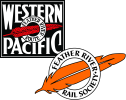SN BALDWIN STEEPLE CABS 440-441 AND 660-661
By Garth G. Groff
To railfans Sacramento Northern's General Electric steeple cabs were the line's best known motive power, thanks to their survival until the end of electric operation in 1965. The importance of the line's Baldwin-Westinghouse locomotives is often overlooked.
Between 1918 and 1927, the SN purchased five standard Baldwin-Westinghouse steeple cab locomotives. Over approximately the same time span, the railroad bought six comparable GE steeple cabs. In fact, purchases alternated between the two builders without any apparent preferences. When one adds in the four Baldwins originally owned by the Oakland, Antioch & Eastern, and the final GE steeple cab purchased used from the Tidewater Southern, the SN's final total was nine Baldwins versus seven GEs.
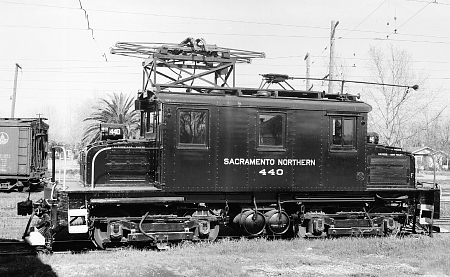
The Northern Electric Railway had stocked itself with home-built locomotives. Their very capable Mulberry Shops in Chico churned out nine locomotives over the span of just nine years. Bankruptcy ended in-house construction in 1915, though the shop continued to do extensive rebuilds of existing locomotives. In 1918 the newly-organized Sacramento Northern Railroad turned to the major builders for "off-the-shelf" locomotives. The first was 62-ton 1030 (later SNRY 430) from General Electric. It was followed by Baldwin-Westinghouse 1040 (later SNRY 440) which weighed 107,100 pounds (final weight). The Baldwin was driven by four Westinghouse 562 motors rated for a total of 400 horsepower. The locomotive could pull just 950 tons between Sacramento and Chico, versus the GE's 1,300 tons. It was equipped with third rail shoes and two trolley poles. Pantographs were still several years in the future.
There has been considerable confusion about the SNRR's first Baldwin-Westinghouse locomotive. This machine has often been described as a Class D, when in fact it was actually a Class B. Part of the confusion comes from Swett's CARS OF SACRAMENTO NORTHERN which claimed it weighed 120,000 pounds, despite a photo showing a much lower figure stenciled on the frame. Although most Baldwin-Westinghouse Class B locomotives were in the 40-ton range, given customer specifications and subsequent modifications, a 50-ton weight is not unreasonable. More than anything else, the 400 horsepower rating marks 1040 as a Class B. Indeed, Baldwin's own catalog makes it clear that Class B locomotives were rated at 400 horsepower. Swett further muddies the creek by listing 1040's length at a rather odd 33' 10", which doesn't tally with Baldwin's 29' 6" for a Class B. Length was apparently measured over the couplers on the SN. Baldwin, on the other hand, listed standard lengths over end plates, since coupler length could vary according to buyer preferences. After deducting the added length for couplers, 1040 falls very close to a Class B's specified length.
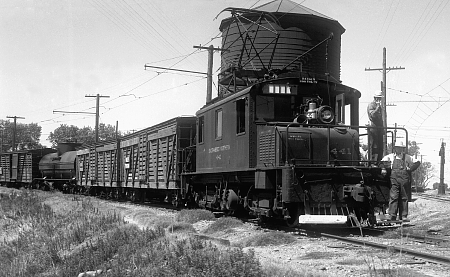
Despite 1040 being less powerful than the rival GE locomotive, the SNRR went back to Baldwin-Westinghouse in January 1920 for two larger Class D locomotives before making another GE purchase. Baldwin 1041 (later SNRY 441) had a final weight of 123,000 pounds and was a very standard 34' 4" over the end plates, typical of Class D. This locomotive had four Westinghouse 577 motors rated at 800 total horsepower. The Baldwin was rated at 1,365 tons between Sacaramento and Chico.
Baldwin-Westinghouse 1042 (SNRY 442) was also built in January 1920. With a final weight of 122,000 pounds and the same motors as her sister, this third motor was rated at a slightly lower 1,300 tons. The difference probably reflects changes made by the SNRY over the years, since the two Baldwins were delivered as a pair and were no doubt identical when new.
The three Baldwin-Westinghouse motors were considered front-line locomotives on the SNRR, and were extensively used on freights between Chico and Sacramento. They were frequently photographed while laying over on weekends at Sacramento's 17th and D Street yard, though actual operating photos are very rare.
Up through the 1920 purchase, the SNRR had owned only 600-volt motors. By 1923 the line was firmly under the control of the Western Pacific, and the new owners already coveted the 1200-volt San Francisco-Sacramento Railroad. When two more GE steeple cabs arrived on the SNRR that year, they were 600/1200 dual-voltage motors. From that point on, all new factory-built locomotives for the SNRR, and later for the SNRY, were dual-voltage for maximum flexibility.
Sometime in the mid-to-late 1920s (the dates have yet to be discovered), all three motors received pantographs. The pantographs were supported on towers made of bar and angle stock to raise them up to the wire which was set at 21 feet above the rails. One trolley pole was removed. In December 1928 1040-1042 were renumbered to SNRY 440-441, when all the 600-volt motors were dumped into the new 400 series during the merger.
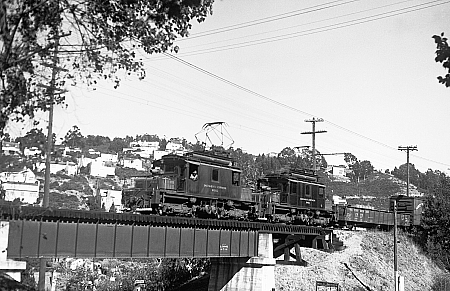
The SNRY went back to Baldwin in 1927 for 1060 and 1061 (later SNRY 660 and 661), the last Baldwins added to the roster. These were also Class D machines, though perhaps on steroids, since their weight and horsepower were near the top of the Class D ratings. Their final weights are listed at 137,300 and 137,650 pounds respectively, but their length over end plates was still a standard 34' 4". Four Westinghouse 583 motors churned out 1,000 horsepower, and the locomotives were rated for 1,650 tons on level track. These two locomotives were the heaviest on the SN after home-built boxcab 1010/410 was chopped down in 1930. The Baldwins were ostensibly purchased for the proposed freight-only Holland Branch, though they actually freed up other locomotives for the new branch. The Baldwins spent nearly all their post-merger careers working the mainline between Oakland and Sacramento. Their heft on the 4.6% grade at Rockridge was greatly appreciated.
The SN management seems to have been well satisfied with their Baldwin-Westinghouse locomotives, though they were less popular with the crews. The engineer sat almost above the trucks. When working in third rail territory there could be dangerous arcs off the third rail shoes. There is no record of any SN engineers being fried by those huge sparks, but the arcs could certainly scare the overalls off them. The arcs could cause the engineers temporary blindness, as well as long-term eye damage. Engineers sat further back from the trucks in the GEs, which made them feel a bit safer. The Baldwin-Westinghouse locomotives, especially 660 and 661, were much noisier than the GE locomotives. Baldwin trucks were rather rigid, making for a rougher ride, though those trucks were much better for switching and starting trains than those under the GE machines.
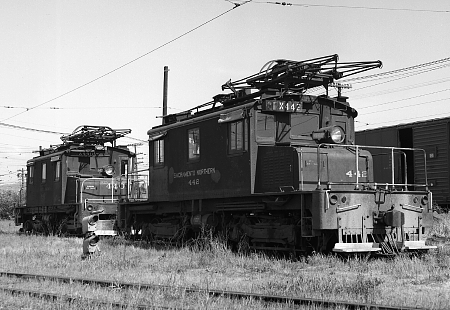
The WP and Santa Fe had jointly purchased the Oakland Terminal Railway in 1942. The OTRY had been the freight arm of the Key System Railways, and was a 600-volt electric line which served the Oakland Army Base and some other industries in Oakland. Two of SN's old wooden flat motors, 404 and 405, were put to work in Oakland. By September 1943, SN 440 joined the wooden motors in OTRY service. All three had their SN pantographs and towers removed, with much taller Key System pans mounted at roof level. This allowed the locomotives to squeeze under a Southern Pacific bridge with low clearance, but still reach the wire on the rest of the OTRY. At a later date, probably 1945 from photos, 442 was given similar treatment and the wooden motors were returned to the SN. The two Baldwin-Westinghouse locomotives remained under lease to the OTRY until the line was dieselized in 1955. The two machines were then returned to the SN and were sold in August of that year for scrap to Essee Iron & Metal in Oakland. Sister 441 had already been junked in January 1954 by the Purdy Company in South San Francisco.
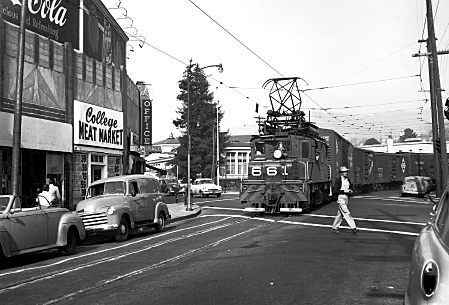
Dieselization of the remaining Sacramento trackage in 1953 freed up more GE steeple cabs for Oakland service. When Baldwin 660 trashed her pantograph and trolley pole in 1954, she went into storage at the WP shops in Sacramento. About the same time, sister 661 was taken out of service and stored at the 40th & Shafter yard. Both locomotives were nearly worn out, and the other SN Baldwins had too many non-matching parts to donate spares to keep 660 and 661 running. When Oakland service ended February 1957, the big Baldwins were finally sold for scrap, again to Essee Iron & Metal.
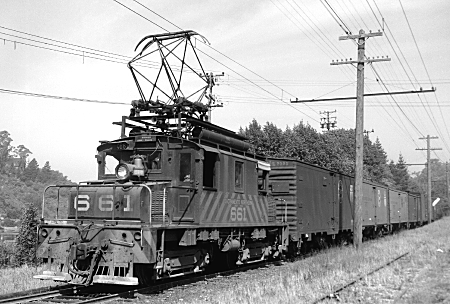
The Baldwin-Westinghouse machines gave good service, all lasting for 30 or more years. Their demise was at first, a clearing out of unneeded older power as electric operation wound down. By the time electrified trackage had shrunk to just the Marysville-Yuba City section in 1957, three locomotives were all that were needed (one in use, one spare, and one for parts). There were just two Baldwins left by then, so the GE motors survived by default. Sadly, no SN Baldwin-Westinghouse locomotives lasted long enough to be preserved.

